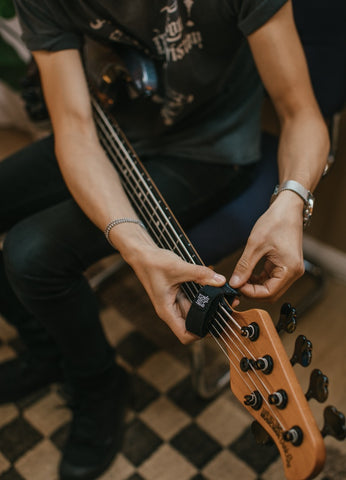By Donna Maurer
There is something about having a recorded guitar session that just feels good. It doesn’t matter whether you are a pro or just starting out. But regardless of experience level, recording the guitar can also be a challenging and, at times, a frustrating experience.
But there are some tips and tricks that can save musicians quite a bit of time and hassle. Streamlining the recording process to get it done in as few takes as possible is the goal. Here, we will show you how to do it once.
Preparing Your Guitar and Gear in Advance
Before you hit the record button, ensure your guitar, amplifier, and all necessary accessories are in excellent working condition. Check your cables, pedals, and other gear for any issues. By keeping your equipment well-maintained, you can avoid unexpected interruptions during your recording session.
Tune Your Guitar
While this may sound a bit obvious, it’s usually the obvious that throws artists for a loop. Even the slightest bit off can result in a funky sound, resulting in multiple takes. While being able to tune your guitar manually is a great skill to have, not everyone feels comfortable with it. Investing in a great tuner and spending the time before recording to go through the process can save hours later on.
Give Yourself a Break
While it can seem counterintuitive, taking more breaks can save you spending more time recording. By pushing yourself too hard, fatigue and frustration will lead to more takes and a longer session. Taking your time and understanding that the process includes mistakes will create a less stressful environment. This is also important for mental health as an artist.
FretWraps are a great tool to use to minimize string noise and unwanted vibrations. When artists can spend more time focusing on hitting their notes and less time on the background music, the take is more sound and clean.
The Struggle with String Noise
Recording guitarists are all too familiar with the issues caused by extraneous string noise and sympathetic vibrations. These unwanted sounds can force you to do multiple takes, wasting precious studio time and energy. In the quest for a clean and efficient recording, many have resorted to makeshift solutions like wrapping bandanas or hair ties around the strings or inserting velcro strips under them. While these methods can be somewhat effective, they are far from ideal and can be time-consuming to set up.
The Role of FretWraps
FretWraps are purpose-built tools designed to mitigate string noise and vibrations. They are typically made of soft, non-damaging materials that wrap around the neck of the guitar, just above the nut. FretWraps exert gentle pressure on the strings, effectively dampening unwanted vibrations while allowing you to maintain your playing dynamics and tone. Here's how FretWraps can help save you time during recording:
- Efficient Setup: FretWraps are easy to install and remove, reducing the time spent preparing your guitar for recording. Unlike makeshift solutions, they won't damage your instrument or affect your playing technique.
- Clean Takes: By taming string noise and vibrations at the source, FretWraps enable you to capture cleaner recordings with fewer takes. This not only saves time but also minimizes frustration during the recording process.
- Focus on Your Playing: With FretWraps in place, you can concentrate on playing your rhythm and solo lines without constantly worrying about unwanted noise. This heightened focus often results in more inspired performances and better recordings.
Recording Tips with FretWraps
To maximize the benefits of FretWraps and save time during recording, consider the following tips:
- Adjust Tension: Experiment with the tension of the FretWrap to find the right balance between damping unwanted noise and maintaining your desired tone.
- Positioning: Proper placement of the FretWrap is crucial. It should be just above the nut, not too close to the frets. Make sure it doesn't interfere with your fretting hand.
- Test and Adapt: Record a short section to test how the FretWrap affects your sound. Make any necessary adjustments to find the sweet spot that works for your playing style and the specific song you're recording.
Recording guitar with precision and efficiency is a goal shared by musicians and studio techs alike. FretWraps provide a straightforward solution to the age-old problem of string noise and sympathetic vibrations, allowing you to save time and focus on creating exceptional music.
By using FretWraps effectively and following these recording tips, you can streamline your recording process, reduce the need for multiple takes, and achieve cleaner, more professional results. So, gear up with FretWraps, and let your creativity flow without the distractions of unwanted noise.
Having An Optimized Recording Space
While vibrations from the strings can cause some background noise, so can the echo from the space you record in. Having a sound studio that absorbs sound rather than bouncing it back can make a huge difference in the quality.
Acoustic treatments like foam panels and other diffusers are the perfect way to go about this. It will save any artist hours of editing and cleanup.
Use a Click Track
New artists may not be aware of what a click track or metronome is. They are the same and can help an artist stay on tempo. This tool is especially helpful if there are multiple tracks or multiple recording artists. Without it, artists can spend too much time editing tracks through manual alignment when they can get it right the first time.
Try Direct Recording
While using an amplifier can be a great tool, some artists prefer to take advantage of technology. What this means is they can use an amp simulation software and try direct recording. Direct recording eliminates the need for a mic. Mic placement and quality of mic add more variables. By plugging into your software, you can increase the sound quality and eliminate multiple takes.
Practice and Rehearse
Another obvious but important pointer is to spend the appropriate time rehearsing and practicing the music before going to record. Without being adequately prepared, the recording process can quickly turn into something someone dreads rather than a great jam session.
This will help reduce the number of takes and ensure artists are thoughtful about the details. For instance, even just holding your guitar pick correctly can change the outcome. Familiarize yourself with the structure of the song, chord changes, and the different solos and tempo of the song. Just like choirs spend time practicing, so should guitarists and bands when they need to synchronize.
Saving Time is Saving Money
Most musicians don’t have the luxury of having their own recording space. For many, this means spending money to rent one out. That’s why coming in completely prepared can make all the difference.
Being well-rehearsed, along with using tools to eliminate sound vibration, will lead to a quality track. It also leads to less time spent editing and more time making music! By implementing these tips and tricks, guitarists at any level can be equipped like any pro!

